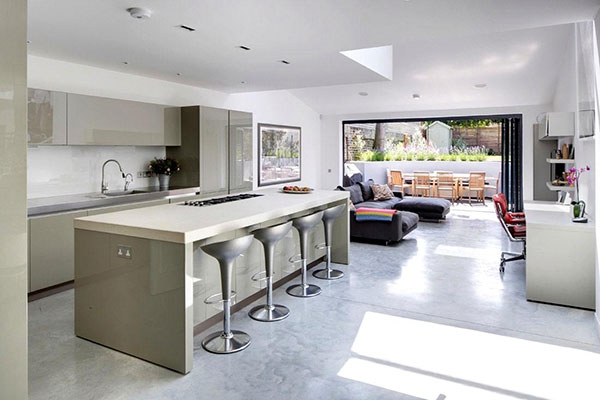BLOG | 10 tips for planning an open kitchen layout
Integrate your living room and kitchen into a seamless space with our easy guideline to planning open kitchens
If there’s one trend we are extremely grateful for, it has to be open plan kitchens. We love layouts where the kitchens and the living rooms are seamlessly integrated. Increasingly, our lifestyles are getting more fluid and the boundaries between different functions are slowly blurring. We love working from the comfort of our home office as much as from the super plush sofa. We love whipping up a quick meal just as much as our turn at squabble. We feel open plan layouts not only look great but also adapt to different needs rather easily. And if it’s something you have been meaning to try but weren’t sure how to, then here’s a quick guide on getting an open plan kitchen right.
1) Plan your kitchen in a way that it doesn’t eat into too much of your living room space. This will result in a cramped seating area when you have guests over
2) An open-plan kitchen makes your house look bigger and hence is the best option for modestly-sized homes. Even large homes can use this style for a contemporary look and way of living
3) Since you are combining two rooms, you need to ensure the style, material and colour palette are in sync in both the areas. This will result in a space that flows seamlessly from one room to the other
4) It is crucial you plan your lighting effectively. The kitchen needs more task lighting to allow safe cooking, while the living space requires soft ambient lighting, especially when entertaining. There must be a balance between the two to allow both spaces to be evenly lit
5) The kitchen area must be kept as tidy and clutter free as possible. This means that daily use appliances like toaster, food processor, blender, etc. must be stored in a cupboard
6) If you don’t want your activities to be visible to those in the living room, raise the height of your platform
7) Make sure you follow the golden triangle of hob, sink and fridge when planning the kitchen. This way you will know how to adjust your utensils and appliances. Having figured out this triangle will also help bring clarity about what part you would like to hide from view
8) If you have a large enough space, you can use a folding glass door. This gives you the flexibility of opening-up or separating the areas while allowing natural light to flow through
9) Indoor plants can make a great partition between the kitchen area and the dining/living room. These will also help mask any odours
10) The best way to block the view of the kitchen from the living room is to create a seating arrangement where guests are facing away from the kitchen
 ARCHITROOM
ARCHITROOM









